Francis Ford Coppola at 80 – 10 of His Best Films
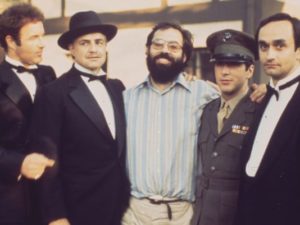
The American director, producer and screenwriter Francis Ford Coppola turns 80 on the 7th April, 2019 and we salute the man who has given us some classic films such as 1972’s The Godfather, 1974’s The Conversation and The Godfather Part II and the Vietnam war film Apocalypse Now (1979). The winner of five Academy Awards and two Cannes Film Festivals for Best Picture, Coppola’s contribution to modern film-making cannot be underestimated and one could certainly argue that he single-handedly revolutionised the contemporary gangster film by way of his Godfather trilogy. During the course of his lengthy career, he has dipped into several genres such as musical, fantasy, drama and crime with degrees of great success and disappointing failure, and his devotion to his craft and to the film-making process has not wavered in over five decades. Coppola’s greatest triumphs and commercial hits largely occurred during the 1970s, but we have not limited our selection of his 10 best films to that particular decade below. Here are our choices in that respect as we mark this milestone in the life of a truly great American filmmaker:
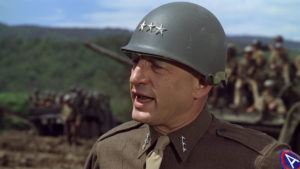
Patton (1970)
This may be something of a stretch on my part I will acknowledge as this 1970 biographical war film about U.S. General George S. Patton was directed by Franklin J. Schaffner and not Coppola himself. The director of Finian’s Rainbow and The Rain People was on scripting duties here as he co-wrote the screenplay with Edmund H. North which was based largely on the biography Patton: Ordeal and Triumph by Ladislas Farago. Beginning with the General’s famous speech to the Third Army and essaying many of his various campaigns during the Second World War (including the Allied invasion of Sicily and the eventual drive through France and Nazi Germany), Patton is a war film of the highest order which boasts a remarkable performance by George C. Scott in the titular role. The actor famously turned down the Oscar he won for Best Actor (citing his personal dislike of the process and acting competitions in general), but Coppola and his co-writer North gratefully accepted theirs in the category for Best Adapted Screenplay. For the record, this was Coppola’s first such golden statuette and the screenplay was selected as the 94th best screenplay of all time by the Writers Guild of America in 2006. A made-for-television sequel titled The Last Days of Patton – which saw Scott reprise his role – followed in 1986, but Coppola had no involvement in this latter project.
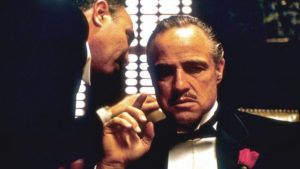
The Godfather (1972)
Coppola’s career was hardly in the strongest place following the mixed reviews and middling box office of 1971’s THX 1138 (which he helped produce) and, indeed, he was not the first choice to helm Paramount Pictures’ adaptation of the 1969 Mario Puzo novel of the same name. A key factor in his eventual choice as director was the desire of then head of production Robert Evans that the film be made by an Italian-American. Coppola’s Italian immigrant ancestry certainly provided this, but the director was at first reluctant to take on the cinematic adaptation of a book which he considered as amounting to ‘pretty cheap stuff.’ Principal photography – which took place in 1971 – was not the happiest experience either and the director was constantly in fear of being sacked at any given moment owing to the budgetary overruns and the implications of some of his casting decisions (Al Pacino as Michael Corleone most especially). A key creative decision by Coppola was to insist that the film be set during the same time period as its source material – namely the 1940s and 1950s. He also won a significant battle when the studio heads allowed him to film on location in New York City and Sicily. The Godfather premiered in March 1972 and proceeded to become the highest grossing film ever made to that time. Contemporary critical plaudits were almost universal as well and the film has continued to enjoy such praise to this very day. It is quite rightly regarded as a watershed film in American cinema history with respect to the presentation of its subject matter and the complex themes which it examines. And let’s face it – it’s also a hell of a production with respect to the expanse of its story, the memorable characters, the famous score by Nino Rota, the atmospheric cinematography of Gordon Willis and the eminently number of quotable lines which pepper its script (“I’m going to make him an offer he can’t refuse”). Hard to believe in retrospect that it only won three Oscars at the 45th Academy Awards (Cabaret dominated that particular year with a total of eight) – Best Picture, Best Actor for Marlon Brando (which he famously declined) and Best Screenplay Based on Material from Another Medium (which Coppola shared with Puzo). Much parodied and often imitated, this remains a bona fide classic of American cinema which led to sequels in 1974 and 1990. In both of these cases – thankfully – Coppola returned to the director’s chair.
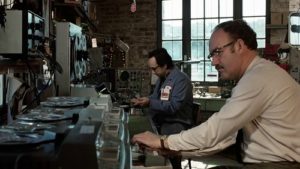
The Conversation (1974)
1974 must surely rank as the best year of Coppola’s career in terms of his cinematic releases. His Oscar-winning sequel The Godfather Part II was released in December and, prior to this (in April to be exact), came this cautionary tale concerning the increasing role of technology in society and the detrimental effects it can have on personal lives. In one of his best – and most understated performances – Gene Hackman plays Harry Caul, a dedicated surveillance expert who comes to believe that his latest assignment will result in a homicide. A superbly realised opening sequence in San Francisco’s Union Square perfectly sets the scene for this unorthodox thriller which co-stars John Cazale, Frederic Forrest, Cindy Williams and Teri Garr. Robert Duvall and Harrison Ford also turn up in smaller, but, nonetheless, crucial roles. Focusing on its central character (a man who is socially awkward and withdrawn), Coppola’s film poses many questions regarding the consequences of action and inaction and the moral dilemma the individual faces for the part he has played in an overarching scheme. The director cited Michelangelo Antonioni’s Blowup (1966) as a key influence in this regard, but rejected contemporary notions that the central narrative thread of his own work mirrored some of the events pertaining to the Watergate scandal which was on-going at the time of the film’s release. The Conversation opened to critical acclaim and won the Grand Prix du Festival International du Film at the 1974 Cannes Film Festival (the highest award of the festival prior to the re-introduction of the Palme d’Or in 1975). The film was also nominated for Best Picture at the 47th Academy Awards, but lost out to the director’s own The Godfather Part II. Did I not previously suggest that 1974 was a very good year for Francis Ford Coppola?
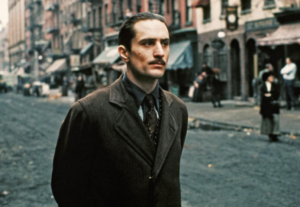
The Godfather Part II (1974)
Rightly regarded by myself and many others as the greatest sequel ever made, Coppola’s follow-up to The Godfather effectively serves as both sequel and prequel. Set largely in the late 1950s, the film concerns itself with the continued ascension and underworld influence of Michael Corleone (Al Pacino) as he seeks to consolidate his business interests and power at home and abroad. Juxtaposed with this is the backstory of his father Vito Corleone (Robert De Niro) as he establishes the family business on the streets of New York City in the 1920s. Coppola stated that the purpose of the parallel dramas was to contrast the story of father and son – one based on a modicum of decency and integrity, the other chronicling the moral decline and eventual emotional vacuum of the central character. The complex structure of the film (which involves flashbacks and prior histories) was not immediately embraced by audiences and critics, but re-evaluations soon followed and The Godfather Part II is now generally recognised as one of the best American films of the latter half of the 20th Century. Personally-speaking, it’s an even better film than The Godfather with respect to the weighty themes which it explores and the performances of its exemplary cast. Robert De Niro won his first Oscar for Best Supporting Actor and the film captured five further gold statuettes in the categories of Best Picture, Best Director (Coppola’s sole win in this category to date), Best Adapted Screenplay (Coppola and Puzo once again), Best Art Direction and Best Original Dramatic Score. The most memorable line of the entire film falls to Al Pacino’s increasingly-callous Michael on this occasion – “Keep your friends close, but your enemies closer.” A second-to-none sequel which more than repays repeated viewing.
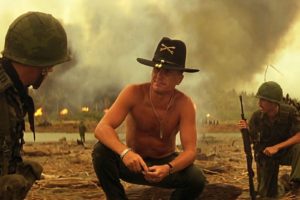
Apocalypse Now (1979)
Surely Coppola’s most talked-about film, Apocalypse Now was certainly beset with more than its fair share of problems during the course of its prolonged production. For starters, there was the location shoot in the Philippines which suffered adverse weather conditions playing havoc with the sets and the schedule. The 1991 documentary on the making of the film, Hearts of Darkness: A Filmmaker’s Apocalypse (co-directed by Eleanor Coppola), chronicles such matters as well as the personal traumas which befell both Coppola himself and his leading man Martin Sheen (who suffered a breakdown on set and a subsequent heart attack). The director’s lot did not improve when Marlon Brando arrived on set overweight and entirely unfamiliar with the source material. Based loosely on Joseph Conrad’s 1899 novella Heart of Darkness, Apocalypse Now tells the tale of one Benjamin Willard (Sheen), an army special operations officer who – during the Vietnam War – is charged with the task of assassinating a highly-decorated colonel by the name of Kurtz (Brando) who apparently has gone insane and now commands his own outpost in Cambodia. Much of the film’s narrative centres on Willard’s journey to Kurtz’s location as he considers the merits of his own mission whilst negotiating the inhospitable terrain of the jungle. In Hearts of Darkness: A Filmmaker’s Apocalypse, an extremely open and frank Coppola relays how he struggled to adapt Conrad’s story and, in particular, to devise a satisfying ending. He also tells of how he feared the film would effectively end his career in Hollywood owing to the spiralling costs and the ill-health of his star. At the 1979 Cannes Film Festival (where a rough cut of the film was premiered), the director used the word ‘insane’ in connection with the film and, famously, declared that ‘My film is not about Vietnam, it is Vietnam.’ It subsequently went on to share the Palme d’Or with Volker Schlondorff’s The Tin Drum and was nominated for eight Academy Awards, including Best Picture and Best Director. From a personal perspective, Apocalypse Now is something of a difficult film for me and it continues to elicit mixed feelings. I greatly admire its ambition and scope, its production values and central performances (Sheen and Robert Duvall in particular), but find myself distinctly unmoved by the narrative which, at times, is ponderous and somewhat self-absorbed. The difficulties which Coppola was encountering with respect to the story are evident in the finished film I think and the eventual ending – whilst visually impressive – is definitely anti-climactic in my opinion. Those reservations aside, there are several memorable moments including the Ride of the Valkyries helicopter sequence and the ‘I love the smell of napalm in the morning’ speech as delivered by Duvall’s Kilgore. The breadth of Coppola’s vision and his engagement with weighty themes can never be in doubt, but the execution of the piece is simply not in the same league as the first two Godfathers or The Conversation. A flawed masterpiece as many before me have suggested? Years later after my first viewing of it, I’m still not sure. Perhaps it’s just one of those films I’ll never quite warm to in spite of my admiration for the man who was at the helm. A challenging motion picture which – though imperfect – also has its moments of brilliance.
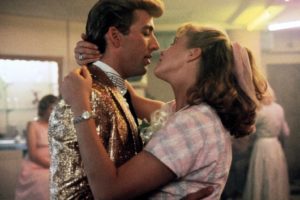
Peggy Sue Got Married (1986)
Following the notable box office failures that were 1981’s One from the Heart and 1984’s The Cotton Club, this 1986 fantasy-drama provided Coppola with a much-needed hit. Peggy Sue Got Married tells the story of Peggy Sue Bodell (Kathleen Turner), a recently-separated woman who attends her 25-year high school reunion in the present day. Passing out during the proceedings (at which she is named the reunion’s queen), Peggy Sue is seemingly transported back to the year 1960 and afforded an opportunity to relive some of her high school days. In the past, she meets her husband Charlie (Nicolas Cage) – her then high school sweetheart – who has been unfaithful to her in the present time. Based on an original screenplay by husband and wife team Jerry Leichtling and Arlene Sarner, Peggy Sue Got Married was something of a departure for Coppola, but lets remind ourselves that he had previously forayed into the realms of fantasy and romance with the aforementioned One from the Heart. 1983’s The Outsiders and the same year’s Rumble Fish had also seen Coppola tackle themes relating to teen angst and coming-of-age so it should not be entirely surprising that the subject matter of Peggy Sue Got Married appealed to him. Apart from its success at the box office, Peggy Sue Got Married received positive critical reviews and three Oscar nominations, including Best Actress for Turner. It’s also notable for its fine cast which includes some very recognisable faces including Jim Carrey, Helen Hunt, Catherine Hicks, John Carradine, Maureen O’Sullivan and Joan Allen. Coppola’s daughter Sofia appears in the role of Nancy Kelcher and his nephew Nicolas Cage – as previously mentioned – plays Charlie. A lively mainstream hit for the director which tapped nicely into fantasy elements akin to Back to the Future of the previous year.
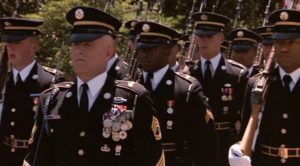
Gardens of Stone (1987)
In contrast to Peggy Sue Got Married, 1987’s Gardens of Stone is a far more sombre piece which was overshadowed by the death of Coppola’s eldest son Gian-Carlo in a speedboating accident during the time of the film’s production. Based on the novel of the same name by Nicholas Proffitt, Gardens of Stone is set during the Vietnam War and concerns itself with a Sergeant First Class by the name of Clell Hazard (James Caan), a war veteran who has conflicting emotions about the war in Southeast Asia and his present duties at the 1st Battalion 3rd Infantry Regiment at Fort Myer, Virginia. When the son of an old army friend – Jackie Willow (D.B. Sweeney) – is assigned to Clell’s platoon, the older man takes an active interest in his future from both a personal and military perspective. The gardens of stone of the title by the way refers to the battalion’s central duty as the ceremonial honour guard for the funerals of fallen soldiers at Arlington National Cemetery. Opening to tepid critical reviews and only middling box office at best, Gardens of Stone is, by no stretch of the imagination, vintage Coppola, but nevertheless remains a thoughtful and elegiac piece. Perhaps there is the tragic death of Coppola’s son which informs the mood of the piece; perhaps it is somehow representative of a filmmaker who was in transition for much of the 1980s; whatever the case may be, this is a film which has many merits, not least the performance of Caan in the main role and a supporting cast which includes Anjelica Huston, James Earl Jones, Dean Stockwell and Mary Stuart Masterson. The final scene – appropriately set at a graveside in Arlington – perfectly encapsulates the themes and tenor of the film. Sam Bottoms and Laurence Fishburne – two members of the Apocalypse Now cast – also feature in smaller roles.
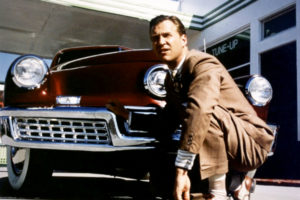
Tucker: The Man and His Dream (1988)
A stylish and touching biopic from the late 1980s, Tucker: The Man and His Dream tells the true story of Preston Tucker, an automobile entrepreneur who sought to produce and market an innovative vehicle named the Tucker Sedan in the late 1940s. Production of the car in question was shut down in the wake of a scandal and accusations of a stock fraud in 1949 and a good deal of the film chronicles the struggles of Tucker – both personal and professional – as he fights against the forces of large corporations in an effort to realise his dream. Jeff Bridges is excellent in the titular role and he is well supported by a cast which includes Dean Stockwell, Christian Slater, Lloyd Bridges, Frederic Forrest, Joan Allen and the Oscar-nominated Martin Landau (Best Supporting Actor). A beautifully shot and designed film (kudos to both Vittorio Storaro and Dean Tavoularis), Tucker: The Man and His Dream is also quite feel-good in its overall tone and serves as a fitting tribute to a man who believed in the American Dream. Coppola referred to it as a ‘labour of love’ and the fact that he himself is the owner of a Tucker goes some way towards explaining his interest in the story. In spite of positive reviews, the film did not perform well at the box office. Having experienced the ups and downs of film-making to an extent that few others have ever done, Coppola was insistent that this would be his last Hollywood film. At the time of the film’s release, he expressed an interest in embarking on a period of ‘amateurism and experimentation as a Hollywood dropout.’ An idea and aspiration which was not so hugely dissimilar to some of those promoted by the subject of this very film.
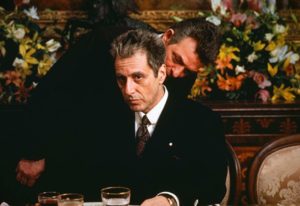
The Godfather Part III (1990)
Coppola returned to the world of the Corleone criminal empire with this 1990 drama which effectively serves as a sequel to The Godfather and The Godfather Part II. Still haunted by the sins of his past, Michael Corleone (Al Pacino) seeks to legitimise the family business by way of a corporate deal with the Vatican which he hopes will atone for some of his former misdeeds. Matters do not go exactly according to plan of course and Michael finds that breaking with his violent past is not as straightforward as he would have hoped. Further complications arise as Vincent Mancini (Andy Garcia) – the illegitimate son of Sonny Corleone – arrives on the scene and fosters a romantic liaison with Michael’s only daughter Mary (Sofia Coppola). The film is also notable for the fictionalised accounts of the 1978 death of Pope John Paul I and the early 1980s banking scandal which engulfed the Vatican as a whole. Bringing the story of Michael Corleone full circle (this is his tragic final act in effect), The Godfather Part III is certainly not in the same league as its two predecessors, but it nevertheless stands up well as sequels go and it received seven Academy Award nominations (including Best Picture and Best Director). Returning cast members from the previous films include Pacino, Diane Keaton and Talia Shire and they are joined by the likes of the aforementioned Garcia, Joe Mantegna, Eli Wallach and Bridget Fonda. One of the chief criticisms of the film centred on the casting of Coppola’s own daughter Sofia in the pivotal role of Mary. The future Lost in Translation director is quite weak in the role to be fair, but not quite as disastrous as some of the reviews of the time suggested. Irish film and theatre actor Donal Donnelly portrays the fraudulent Archbishop Gilday. Coppola’s father Carmine was once again responsible for the music.
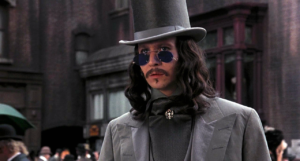
Bram Stoker’s Dracula (1992)
Coppola crossed effortlessly into the genre of gothic horror with this fine screen adaptation of the 1897 novel by Irish author Bram Stoker. Starring Gary Oldman as the titular Count Dracula, the director’s take on the classic tale is a welcome and fresh reworking which places strong emphasis on character motivation and personal need in the context of an overarching love story. A restless spirit for several centuries, the Count is presented to us in a generally sympathetic light as one who is ultimately seeking peace and resolution. Oldman’s performance nails it with respect to this central theme and he is well supported by Winona Ryder (as Mina Harker) and a slightly over-the-top Anthony Hopkins (as Professor Abraham Van Helsing). The less said about Keanu Reeves’s Jonathan Harker, the better. As always with a Coppola film there is much to admire about the visual style of the piece, as well as the production design (Dracula won Academy Awards for Best Costume Design, Best Makeup and Best Sound Editing); one key decision which the director made was to film on sound stages in order to avoid bad weather and resultant cost overruns. The result is a film which is splendid to look at, but one which also manages to re-imagine the timeless story for a new generation of cinema-goers. Coppola also includes some visual allusions to previous films in the genre, most especially F.W. Murnau’s 1922 Nosferatu. Audiences responded well and with a box office haul of $215 million, the film went on to become the 9th highest-grossing film of the year worldwide. Additional cast members included Richard E. Grant, Cary Elwes, Sadie Frost and Tom Waits. Coppola’s son Roman collaborated on the visual effects.